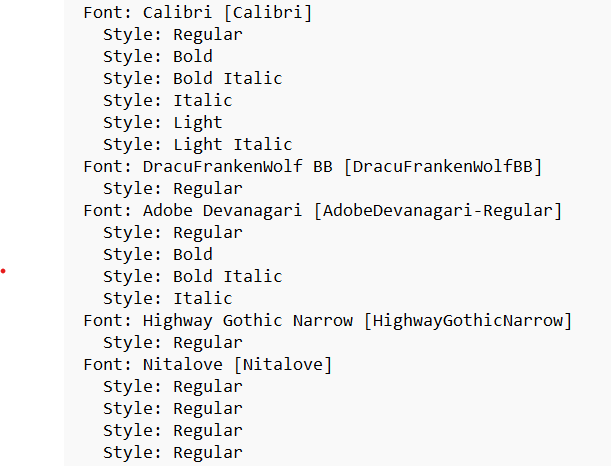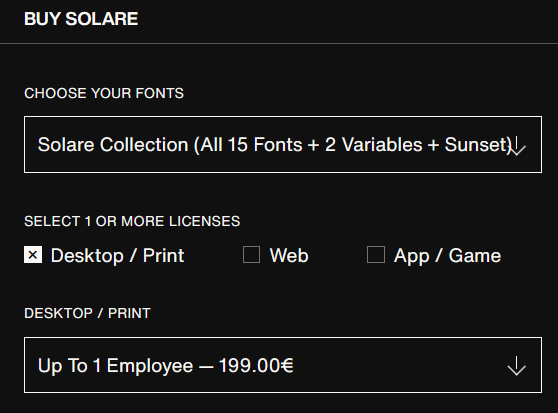Search the Community
Showing results for 'variable fonts'.
-

Variable fonts support
Komatös replied to Athanasius Pernath's topic in Feedback for the Affinity V2 Suite of Products
The Affinity programs cannot read certain proprietary data in the Adopay file formats; Serif would have to license an API from Adobe for this. And that three times (APhoto, ADesigner, APublisher). This means three license fees per suite sold. Try to open your files in https://www.photopea.com And as far as your variable font problem is concerned, check whether the fonts are also available in the static version. -

Variable fonts support
JGD replied to Athanasius Pernath's topic in Feedback for the Affinity V2 Suite of Products
Adobe seems to support them just fine. Of course, they are both the creators and main implementers of the PDF format, and creators, distributors and heavy promoters of variable OTF fonts, seeing how it's just a development of their old Multiple Master format (seriously, the other day I was playing around with a really old version of Illustrator, running on System 7.6 on top of Basilisk II, and I was absolutely shocked at just how similar the interface for manipulating Type I MM fonts was to their current implementation), so they obviously have their work cut out for them. Unless Adobe, Corel et al. have some sort of weird patents, it should be just a case of opening their files and reverse-engineer them. Voilá, presto! Anyway, and AFAIK from my own look into it way back when, Adobe's apps just take whatever interpolated values you picked and export the end result as bespoke, automatically-generated and embedded fonts for the relevant text strings (yes, a separate one for each combination of variables), so there's no need for converting stuff to curves, losing the ability to select text or ballooning file sizes, the works. Of course, when reimporting, you absolutely must have also an embedded Illustrator file stream, otherwise you're completely screwed. Perhaps you could look into making your own implementation of PDF files with embedded .afdesign or .SVG streams, or just metadata for the relevant text strings to save on file size, so that one could in theory reconstitute those multiple resulting fonts into their parent variable OTF fonts/styles? As others have said, variable OTF fonts are just not going away; not this time, and especially not with the might of Adobe TypeKit and Google Fonts behind them. Heck, even I wrote a paper on those; you can check it out in my ORCiD page in my bio if you want. And, as I've said before, my students are really using them in earnest (… as attested in said paper), which means that when they leave the Uni and enter the workforce, they'll either keep using Adobe CC, or switch to something else altogether, like Sketch. I know you don't like to hear this, and please don't shoot the messenger, but… I did warn Serif (a company called, of all names… SERIF!) years in advance of just how relevant and pervasive they would become. 🤷♂️ I cannot stress this enough, and to all the people rightly clamouring for RTL support: variable OTF font support should be included in a splashy v.2.x update (not a v.2.x.x one, but a full-blown point update, and maybe even a jump to v.2.5 for good measure), and RTL could very well wait for v.3… Allow me to explain: the RTL market is not even considering Affinity apps at the moment, at all, so they're not exactly invested in them, whereas a lot of designers, be they young and aspiring or established veterans, may have bought Affinity 1.x (let alone 2.x, because this thread and all related discussions date back to the v.1 days, if I may remind you all), with the expectation of it being a professional package somewhat approaching feature-parity with its peers (in their Latin-centric bubble, for sure, but it is undeniable that the vast majority of the design market in the West indeed doesn't need RTL; and full disclaimer: I'm a type designer with two finished but as of yet not commercially available fonts which support Arabic, so I fully understand what's at stake and feel RTL users' pain). And variable fonts being an external development, long in the making and over which Serif does not have much control, they are something third-party developers must adapt to and properly support, ASAP, and not the other way around. As I've said, the penalty can actually be people switching back to whatever software package they were using before, or to a different alternative to the proverbial 800lb gorilla in the middle of the room, just so they can stay up-to-date and competitive. The best way Serif can ensure people stay in the Affinity bandwagon for v.3 is to give them the bare essentials, and typography being the basis of design (think about it; other media and visual resources such as, say, photography or illustration can exist in standalone form, but not typography, or not to the same extent), yep, supporting the most popular formats available is as essential as being able to import and export in all popular vector and bitmap formats. Would you like being limited in what camera, or drawing tablet, or brush packs, or whatever you could buy for your creative endeavours because your supposedly very much up-to-date software package of choice refused to support them? Now extend the same exercise to something as basic as typefaces… -

Variable fonts support
PaulEC replied to Athanasius Pernath's topic in Feedback for the Affinity V2 Suite of Products
There are plenty of free fonts (not variable) from Google Fonts, and elsewhere, you don’t need to spend lots of money! -
Variable fonts support
Ryan Clarke replied to Athanasius Pernath's topic in Feedback for the Affinity V2 Suite of Products
Do you even consider the fact that some people choose not to use Adobe out of PRINCIPLE? I can afford to use Adobe products, but I despise the companies practises. I also don't want software that crashes every ten minutes like Photoshop and Premiere. However, I am really miffed to have bought the whole Affinity suite to find out that I cannot use variable fonts. It's a bit rich to promote a product so heavily as an affordable alternative, when you would need to outlay thousands of pounds to equip yourself with fonts in Affinity that you can get for free from Google. Furthermore, learning any piece of software is an investment in itself. A huge investment. Do I really have to go and spend weeks learning how to use InDesign now, and putting up with all the errors and crashing because Affinity is only interested in the amateur marketplace? 4 years of complaining and not a peep out of the developers. Shame on you. -

Include Variable Fonts
kemie replied to Friksel's topic in Feedback for Affinity Designer V1 on Desktop
One year later still waiting for this: Variable fonts allow users fine control over typographic properties such as weight and width, beyond what regular fonts can do. I hope Affinity can finally support them. -
Thanks for responding, Walt! I looked a bit more into the particular font files, and they indeed are variable. Each file is meant to be a different "instance" of the variable font. I tested it in MS Word just to be sure, and it also breaks there. However, MS Word does render the Black weight of the font correctly, and some other weights incorrectly. Hopefully a future version of Affinity will support variable fonts.
-

Font style names all the same
walt.farrell replied to Paul Mc's topic in Affinity on Desktop Questions (macOS and Windows)
That's part of the issue with Variable fonts: they're not supported in PDF files. Instead, the application needs to generate Static versions of the fonts to embed in the PDF file, and Affinity doesn't do that. -

Font style names all the same
walt.farrell replied to Paul Mc's topic in Affinity on Desktop Questions (macOS and Windows)
The solution is to avoid using Variable fonts; only Static fonts are supported in the Affinity applications. Your client will need to provide a statis version of that font, or you will need to use a different application. -
You have a number of Variable fonts installed, I think. That probably does not account for startup problems, but they aren't supported in the Affinity applications and won't work properly in them. Compare the Style listings for Calibri and Nitalove, for example. There are others like Nitalove that show multiples of the same Style. I'm not sure how to explain what Cascadia Mono shows, unless this means you have multiple copies of the font installed. Again, I would not expect that to cause startup problems, but could cause issues working with the font in the Affinity applications: Sitka also looks odd, to me. And several others. I'm also seeing multiple sets of listings for some of these fonts (including Cascadia Mono, Sitka, and Segoe UI Variable), and I don't know how to explain that.
-
Variable fonts support
garrettm30 replied to Athanasius Pernath's topic in Feedback for the Affinity V2 Suite of Products
I really want variable fonts myself, but your example is unfortunate and I am afraid doesn’t help the cause. The font of these posts is Inter, and while it is now available in variable form, this forum software is requesting the static forms from Google: <link href="https://fonts.googleapis.com/css2?family=Inter:wght@300;400;500;600;700&display=swap" rel="stylesheet"> Edit: the above is mostly true, but it may still be delivered from Google as variable anyway (see next post). I would delete this post, but as some may have already seen it, I need to correct it instead. -
Variable fonts support
Alfred replied to Athanasius Pernath's topic in Feedback for the Affinity V2 Suite of Products
Support for variable fonts is completely different from CJK text handling. -
Let me take these responses in order: 1. Variable Fonts? I don't think so. These are TTF, not OTF. 2. "No longer maintained". There are probably hundreds of thousands of fonts that are "no longer maintained." They are not operating systems. Are you suggesting that Affinity will only work with fonts that are currently being maintained? Even with some extremely old font collections, from WordPerfect 2000, MS Office 97, Lotus (1995), Harvard (1994), and the Bitstream Font CD (1993), I almost never see problems. The Libertine/Biolinum fonts are not crude fonts hacked together in someone's basement. They are fairly full-featured unicode replacements for Times New Roman and Arial, supporting many codepages, ligatures, and internal support for smallcaps, as well as other typographic features. 3. "several glyph errors throughout the font family." Are you saying that these glyphs are what is causing Affinity to choke on the italic font? Or are the glyph errors in some unicode chinese characters that are not even being used? Is this relevant to the problem being experienced? 4. "Libertine Initials and Italic have the same postscript name." Are you suggesting that opening the font in a font editor and changing the postscript name will fix the problem? 5. "...old fonts from SourceForge have errors in the name fields. That is what is most likely causing your errors." See #4 above. Are you saying that if I fix the name fields in a font editor, it will all work? This opens another question. Why is it that LibreOffice, Gimp, Inkscape, Foxit Phantom, and Abbyy FineReader have no problem with these fonts, and do not confuse the initials and the italic versions, and do not radically mess up the font kerning for the Italic face, like Affinity does, even though apparently, these two fonts (italic and initials) have the same internal postscript name. How is it that these other software avoid having this problem, but Affinity cannot avoid it? It seems to me that there is a weakness in the method that Affinity is using to identify the fonts. Wouldn't it be better to fix this? 6. "I would un-install all the G fonts." Yes, I would like to do this, but I can't, because I have many books on my website, that still have those fonts, and I eventually need to load them and replace the fonts. Some of them have carefully placed images, and if the font used does not exist on the system, it may get substituted, and the paragraphs reformat, throwing the pictures askew. To prevent having to do even more work, I keep both font series installed, do a search and replace on font format, and this way the pages and paragraphs stay pretty much the same. It's the least disruptive way (that I know of), and saves headaches. 7. "The Libertinus font family is an updated...version..." I wasn't aware of that. I have downloaded and installed it. I will tentatively experiment with it. I can't immediately jump into a font replacement without careful consideration, as I have hundreds of books, some of them over 1000 pages, that would all need to be redone, and that is probably a years work or more. So I have to move carefully. If you change the foundation on a grass hut, you can do it in one day, and change it again the next. If you have to change the foundation on a skyscraper, it requires much more thought and careful planning! I read on a wikimedia post that OTF does not display on screen as well as TTF. The post was from 2015 though, so maybe this is no longer the case? This would be a concern for me, as most of my PDF's are primarily for reading (on computer or iPad/Tablet), and only secondly for printing. I wouldn't want to compromise the reading quality. *** So I tried my test document with the "Libertine G" series of fonts and opened it in Affinity Publisher. It was even worse. See the attachment. The missing characters are one of the reasons I switched from "Libertine G" (or "Libertine O" on Linux) about 4 years ago. When I used them in the past, the G fonts looked fine in a PDF, but if you attempt to copy out the text, some PDF viewers would leave out characters, especially where ligatures were involved. I think it was Chrome and Foxit Reader that had problems, whereas Edge and Adobe Reader worked (I might be mixing these up). I also tested the same document, this time using "Libertinus". The result was successful, but interestingly, I had to choose font substitutions first (which I didn't have to do with the other Libertine/LibertineG fonts), as it could not find the original fonts (because when they are stored in PDF, somehow the name is combined without spaces (LibertinusSerifRegular) and so does not match any installed fonts. Affinity would have defaulted to Arial, but once I picked the substitutes, it worked fine.
-
Variable fonts support
Stepaan replied to Athanasius Pernath's topic in Feedback for the Affinity V2 Suite of Products
I had to revert back to the terrible Illustrator just because of lack of variable fonts support in Designer. I almost forgot how outdated the Illustrator really is. Sure they have this 'awesome' text-to-vector 'AI' (huge selling point to some), but the UX and the user experience is awful. Adobe even messed up the variable fonts support in the newest InDesign 2024. So yes, please, make the variable fonts possible across the Affinity Suite. Please! -
Agreed, along with variable fonts, and this has been brought up many times in the past. For something like this particular example you can use a normal font and make the text a mask for a picture (in this case of a flag) behind the text, but it would obviously be more convenient to use a pre-rigged font like that, and other examples of color fonts may not be quite so easy to mimic in that manner.
-
I see no issue with the ... replacement with the ellipsis using your Karla font (v2.002, 2020). Same in your document. It appears to work fine. It only replaced it with Arial when the Karla font was not available. I noticed you included the Karla variable fonts above. You cannot have the variable fonts installed at the same time as the static fonts. Google Fonts configures the variable fonts instance names to be same as the static fonts style names - so they conflict if both are installed at the same time. This could be your problem if you have both installed. Affinity applications can get confused by the duplicate names - with unexpected results. Such as treating a font as missing and thus replacing with another font. So if you have the variable fonts installed, un-install them. The underline is changing with the replacement font change. Fix the replacement font issue and that should fix itself. That is inside the font. The point is that how the font designer has set this may affect the vertical metrics. Wow. Basic desktop publishing knowledge appears to be lacking here. Check the docs and other DTP info sources about "leading". Affinity does not have control over the "auto" - only you and the font designer do. There are multiple settings within the fonts and they are used differently by different operating systems (and by different applications). That was the point I tried to make above. "auto" takes the default leading set by the font designer. The problem is that "default" is often calculated differently by different operating systems. So the solution is to use a fixed leading measurement which is the same no matter the OS. Your Karla font (v2.002, 2020) does have "Use typo metrics" set to On. Which means that measurement should be used on both OSs. What could be happening is that since you have "auto" set for leading when the font is replaced it is picking-up the leading from the replacement font (which is obviously different). Using a fixed leading would also fix that. So first, do not have the variable fonts installed - that may be the main problem. If that is not the issue, I am out of ideas. Note: there is a Karla v2.004, 2023 available now (but that should not affect this).
-
In my example above it was a font from Adobe Fonts (not a variable one). The bug also occurs if I replace it with Montserrat. I attached a test file. test.afdesign
-

Variable fonts support
walt.farrell replied to Athanasius Pernath's topic in Feedback for the Affinity V2 Suite of Products
-
Hi @BarbaraSki, Is the font in question static or variable? If the latter this will be because Variable fonts are not supported in Affinity apps so you would need to use a static version for the file to export correctly. Also, note that the PDF spec doesn't support variable fonts... If this is not the case, could you let us know which font is causing the issue for you?
-
Fonts not being interpreted correctly when exporting to PDF
cynicRMN replied to stutes's topic in V1 Bugs found on macOS
I had a similar problem. I created a layout with Raleway (Google Font). I had downloaded the variable weight font file from Google. Everything displayed correctly in the Affinity Publisher app. When I went to export the PDF, it just showed regular Arial font. I deleted the variable weight font file and downloaded the individual font files from Google and restarted the app. I had to replace the fonts in my file with the new Raleway fonts and boom then it exported fine. It took about an hour of frustration before I figured this out. I hope this helps someone else. -
Variable fonts support
fde101 replied to Athanasius Pernath's topic in Feedback for the Affinity V2 Suite of Products
QuarkXPress comes in at a significantly higher price point than the entire Affinity suite, and they do not seem to fully support variable fonts yet either (though they have said it is on the roadmap for several years now). -

Text not visible
thomaso replied to RachelPerez12's topic in Affinity on Desktop Questions (macOS and Windows)
Note that Affinity does not support Variable/Colour Fonts yet. – Compare this recent thread with possible workarounds: -
Variable fonts support
DR34MER replied to Athanasius Pernath's topic in Feedback for the Affinity V2 Suite of Products
I get that, Thomas. Even the simplest things are often significantly more complex than we think. Honestly, I’d rather see R&D budget prioritized for something important that has no workarounds like variable fonts instead of it going to on a tool like vector tracing that we can workaround doing by hand. -
RTL text is a line composing convention, not a font format. If Serif wants Affinity Designer to be used by a lot more people globally they'll need to support Hebrew, Arabic, Urdu and other scripts. Let's not forget about vertical text used in nations like Japan. But that's a different matter than support of font formats. Variable fonts are not going away. The OTF Variable format is already far more successful than the Type 1 Multiple Master and TrueType GX formats from the 1990's. I use variable fonts frequently in my design work. Whenever I'm considering to buy a new typeface package I'll check to see if it includes any variable fonts as well as how many variable axes it includes. It's just as much a selling point as a typeface having an expanded character set with lots of OpenType features.








